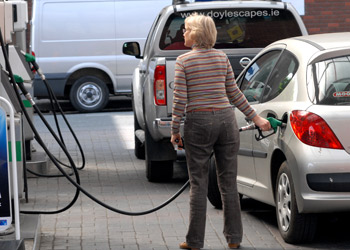Higher energy prices affect growth

As energy prices rise to record levels the impact of ever-higher fuel, electricity and heating costs is emerging as a significant drag on economic growth
10 May 2012
Last month, according to figures compiled by the AA, the average price of a litre of petrol at the pumps hit 164.9 cents while a litre of diesel averaged 159.9 cents. These are the highest average monthly prices ever recorded by the AA since it first began tracking average fuel prices more than two decades ago.
Higher crude oil prices on international markets are part of the reason for sky-high fuel prices with Brent Crude trading at the equivalent of $116 a barrel earlier this month. Natural gas prices are also at elevated levels, with UK natural gas trading at almost 60p a therm.
However, higher prices on the commodity markets provide at best only a partial explanation for the higher prices that Irish consumers and companies are paying. After all it’s not as if we haven’t been here before. Crude oil prices peaked at almost $150 a barrel in mid-2008 while natural gas prices have hardly budged over the past 12 months – natural gas is particularly important for this country as most of our electricity is generated in gas-fired stations.
Exchequer accounts for half of cost
A crude oil price of $116 a barrel still only works out at the equivalent of less than 56 (euro) cents per litre. So where is the other more than EUR*1 per litre going? The oil companies and the petrol forecourts take their cut for refining, distributing and retailing the fuel but by far the largest proportion of this amount goes to the Irish government in taxes, both excise duties and VAT with approximately 57% of the price of a litre of petrol and 51% of the price of a litre of diesel finding its way to the exchequer in the form of excise duties and VAT.
In recent years other forms of energy have also been dragged into the tax net. Dressed up as carbon taxes, in reality a method of extending fuel excise duties to other forms of energy, solid fuel, natural gas and electricity are now subject to tax also. For this if for nothing else the Green Party fully deserves the electoral extinction it suffered at the hands of voters in the February 2011 general election.
These higher energy prices are forcing consumers to reduce their usage. Insurance company FBD noted that motorists are now driving less, in the interim management statement it issued to shareholders at the end of last month.
It is almost certainly a similar story with other forms of energy consumption. While the extraordinarily mild winter of 2011-2012 certainly helped companies and households to reduce their energy consumption, higher prices contributed also.
Feeling the effects
There is also clear evidence that higher diesel prices are hitting the distribution sector hard. On 26 April a liquidator was appointed to logistics company Flancare, which with depots in Longford and Clonmel, is one of retailer Dunnes Stores’ main centralised distribution contractors.
While there is as yet no evidence of what, if any, contribution higher fuel prices made to the Flancare collapse, Irish Road Hauliers Association representatives told an Oireachtas Committee last January that, as a result of rising fuel prices, for many of its members “their backs are to the wall and they are at the end of their tether”.
Long term implications
Just in case the assembled parliamentarians didn’t grasp that higher Irish excise duties and VAT represented a large part of the problem, the IRHA pointed out that many Irish hauliers were now filling their tanks in Belgium rather than Ireland, with the Irish taxpayer losing EUR*600 every time this happened.
However, while higher energy and fuel prices will undoubtedly have an impact on the performance of the economy in the short term, the long-term implications will almost certainly be less severe than the pessimists would have us believe.
China’s inefficient use of energy
One of the main factors pushing energy prices higher has been soaring developing country demand, particularly from China. However, it might not be a good idea to bet on this trend continuing uninterrupted. This is because as its one child policy starts to bite, the Chinese labour force will start to shrink within the next few years. Throw in the fact that wage rates are rising at an annual rate of 15%-20% in most Chinese cities and it is clear that China is going to have rely on something other than low labour costs to maintain its international competitiveness.
That something is likely to be energy. Having already overtaken the United States to become the world’s largest energy consumer, China has up to now been extraordinarily inefficient in its use of energy. It consumes more than 10 times as much energy per unit of economic output as does its Far Eastern neighbour Japan.
While the country had a virtually infinite supply of cheap labour, that didn’t matter. It does now. Japan almost certainly provides the likely template. In the early 1970s Japan was, like China today, profligate in its energy consumption. Then the first oil price shock hit and Japan, which imports the vast bulk of its energy, realised just how vulnerable it was and acted accordingly.
In the space of less than a decade Japan went from being one of the world’s least efficient consumers of energy to being one of the most efficient.
Could China follow Japan’s lead?
Could something similar happen in China? Almost certainly yes. Already the country is investing heavily in new “green” energy technologies.
The need to dramatically improve its energy efficiency and the huge investment it has made in new energy technologies almost certainly means that the dramatic increase in Chinese energy consumption seen in recent years will not be sustained into the future.
Could we see a repeat of what happened in the 1980s? In 1981 in the aftermath of the crisis unleashed by Iran’s Islamic revolution oil prices peaked at $39 a barrel, the equivalent of over $120 today when adjusted for inflation. Then as now the end-is-nigh brigade were out in force predicting that energy prices would rise to previously unimagined heights. Instead by 1985, just four years later, the price of oil had collapsed to just $8 a barrel.
Will something similar happen this time around? If it does stand by for further tax hikes as the government pockets most of the savings.



 Print
Print






Fans 0
Followers